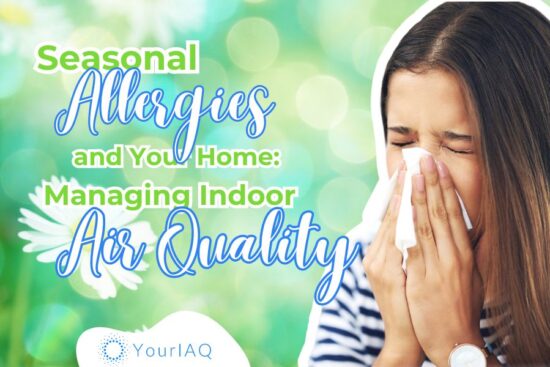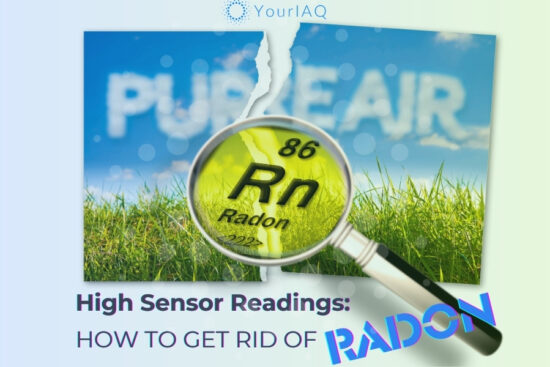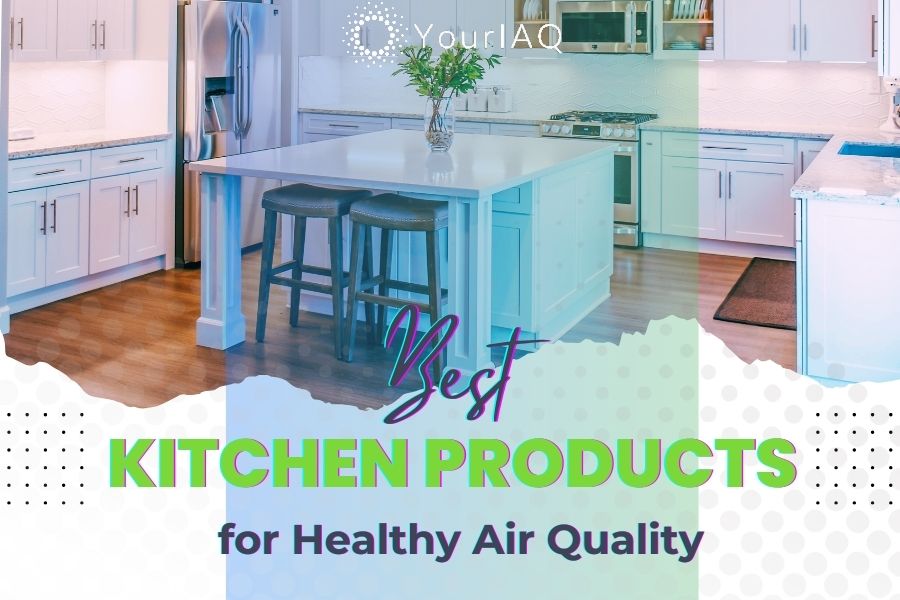
The kitchen is the heart of many homes, but it can also be a hidden source of indoor air pollution. Cooking fumes, cleaning products, and even the materials we use release harmful chemicals and particles into the air we breathe.
Did you know that indoor air pollution from cooking can sometimes be worse than outdoor air quality? The dangers of cooking without ventilation include exposure to toxic fumes from cooking oil.
Luckily, there’s a way to combat this hidden threat: choosing eco-friendly kitchen products.
Upgrade for Clean Air: The Best Eco-Friendly Kitchen Products
It’s time for a kitchen air quality upgrade! We’re diving into the best eco-friendly products for your kitchen. From the appliances you use to the dishes you eat from, these conscious choices will help you breathe easier and make your kitchen a more sustainable space.
Here are a few top picks to get your kitchen air quality upgrade started:
1. FOTILE JQG05 Range Hood – Your Best Defense Against Kitchen Fumes
Cooking fumes contain pollutants that can affect your health and comfort. The FOTILE JQG05 Prestige Range Hood creates a healthier kitchen by minimizing your exposure to airborne irritants in the kitchen. It removes up to 98% of odors and 95% of oil and grease, has a 30-inch inlet that effectively covers standard burners, ensuring that fumes are trapped at the source and prevented from spreading throughout your kitchen, and the automatic delayed shutoff guarantees complete air purification, leaving your kitchen truly fresh.
The FOTILE JQG05 tackles those problems head-on with its innovative technology. It features a filter-less design, powerful WhisPower Motors, and a Capture Shield. This translates to a higher CFM rating. CFM (cubic feet per minute) measures airflow – the higher the CFM, the more pollutants it removes.
Important Note: The advanced technology and sleek design of the FOTILE JQG05 do come with a higher price point. If budget is a major concern, there are other range hood options available, though they may not offer the same level of performance.
2. MOOKA Air Purifier – Best Kitchen Air Purifier
While a good range hood is your first line of defense, a kitchen air purifier adds extra protection.
The MOOKA B-D02L Air Purifier tackles kitchen air pollution with a powerful, multi-stage filtration system. It has a True HEPA Filter that removes tiny airborne pollutants down to 0.3 microns and has an activated carbon filter that traps stubborn odors and chemical gases released during cooking.
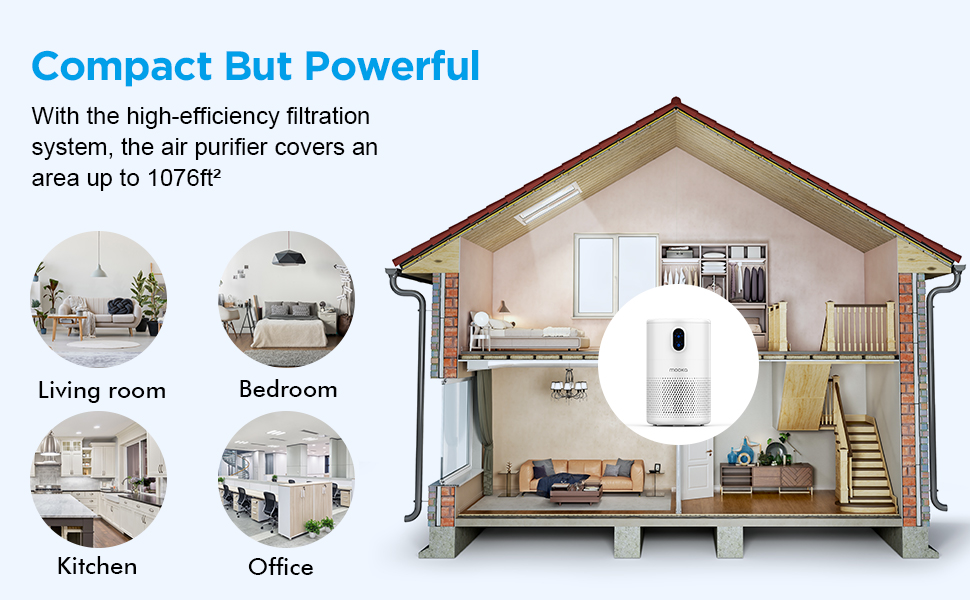
Say goodbye to stubborn cooking odors permeating your home. It’s also energy-efficient, providing worry-free, cost-effective operation. The MOOKA Air Purifier works perfectly alongside your existing range hood for maximum air quality improvement in your kitchen.
3. Ditch Gas & Electric for Healthier Air: The GE Profile Induction Range
Traditional gas or electric cooktops can contribute to increased heat in your kitchen, wasted energy, and even release harmful pollutants like nitrogen dioxide into your home. This affects both comfort and overall air quality. The GE Profile Smart Slide-In Induction Range combats those issues with its innovative technology, sleek design, and focus on efficiency.
How it works:
- Induction Cooking: This method uses magnetic fields to directly heat your cookware, offering fast heating and precise temperature control while minimizing wasted heat.
- Smart Features: Enhance efficiency with features like app connectivity, guided cooking, and automated temperature adjustments.
- Modern Style: The range’s sleek design seamlessly updates
- Certifications: Meets ADA standards for accessibility and features a high percentage of US-made components. California Prop 65 compliant.
Induction uses less energy and releases fewer pollutants compared to traditional stoves, creating a healthier kitchen environment. Faster cooking, precision control, and smart features translate to less time and energy spent in the kitchen.
4. GreenPan Valencia Pro: Ceramic Nonstick Pan for Healthy Cooking
Many traditional nonstick pans use coatings that contain potentially harmful chemicals like PFAS (Per- and polyfluoroalkyl substances or the “forever chemicals”) and PFOA (Perfluorooctanoic acid). When overheated, these coatings can release fumes or degrade, contributing to poor indoor air quality.
The GreenPan Valencia Pro offers a healthier cooking experience and helps minimize kitchen fumes with its advanced ceramic nonstick technology. GreenPan Valencia Pro’s Thermolon™ ceramic nonstick provides a safer cooking experience. Its coating is completely free of harmful chemicals like PFAS, PFOA, lead, and cadmium, minimizing your exposure to potential toxins.
The durable coating performs reliably, even at high temperatures, without releasing harmful fumes. The pan’s oven-safe design expands your cooking options, allowing for seamless stovetop-to-oven transitions.
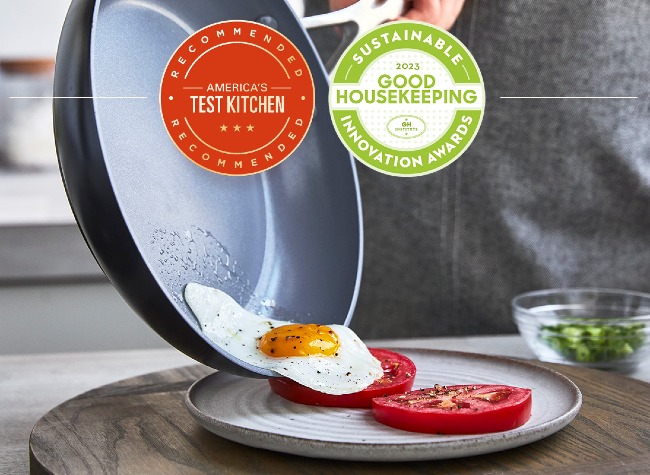 |
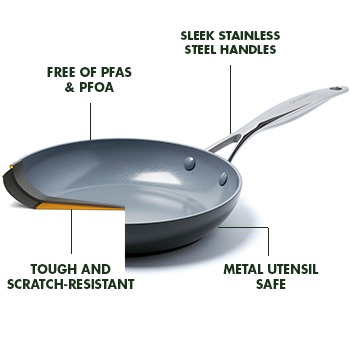 |
| Green Pan Valencia is the recipient of America’s Test Kitchen Winner for the Best Ceramic Nonstick Frypan and 2023 Good Housekeeping Sustainable Innovation Award (Image credit: Green Pan) | |
5. Duralex Glass Storage Containers: Durable and Non-Reactive
Plastic food containers contribute to kitchen pollution in multiple ways.
Some plastics can leach potentially harmful chemicals into your food, especially when heated, compromising food safety. Their short lifespan leads to frequent replacements and waste, which can end up in landfills.
When plastic degrades or is incinerated, it can release harmful compounds into the air, impacting indoor air quality. Additionally, the production of plastic itself contributes to pollution and greenhouse gas emissions.
Duralex offers a healthier, more sustainable alternative to plastic storage:
How they work:
- Tempered Glass: Duralex’s special process makes their glass exceptionally strong and resistant to breakage.
- Chemical-Free & Non-Reactive: Glass ensures your food stays pure, with no leaching of flavors or chemicals.
- Versatile & Durable: Handles hot and cold temperatures, plus they resist chipping and staining for a long lifespan.
6. Vetrazzo Recycled Glass Countertops: Beauty and Sustainability
Some traditional countertop materials have a significant environmental impact – their production can contribute to pollution, and some may even off-gas harmful chemicals into your kitchen over time.
Vetrazzo recycled glass countertops offer a beautiful and eco-conscious solution with impressive certifications, including NSF Certified, LEED Credit Eligible, and Cradle to Cradle Certified. Each slab is a unique work of art made from upcycled glass, diverting materials from landfills.
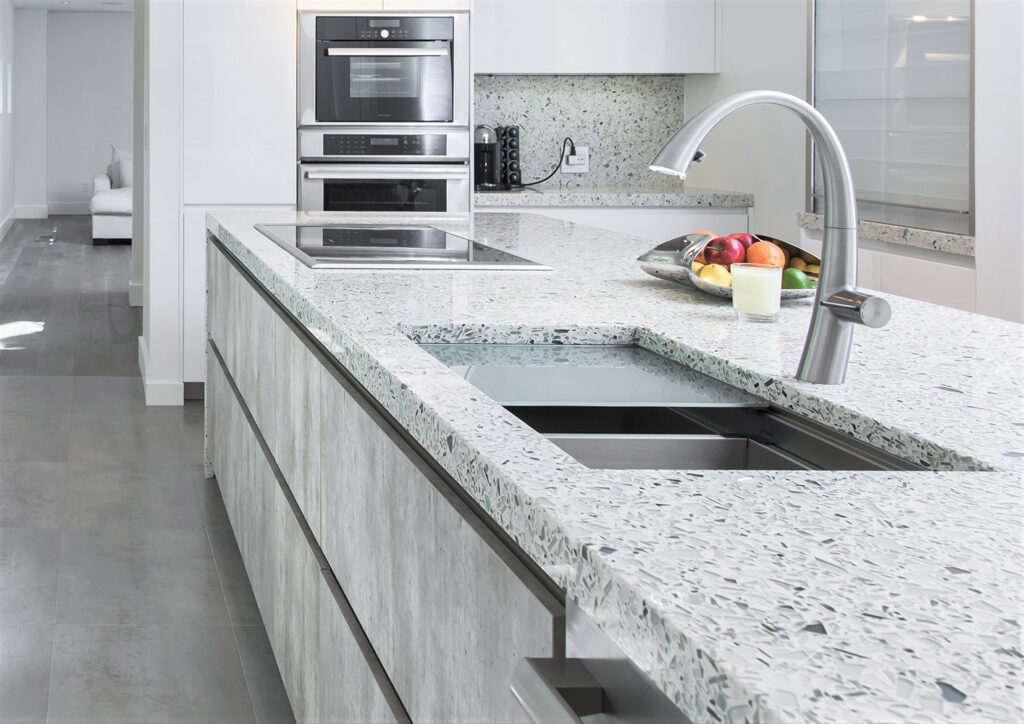
Moreover, Vetrazzo’s non-porous surface resists stains and bacteria, ensuring a hygienic prep space while minimizing potential indoor air pollutants.
Vetrazzo’s inert material makes it an excellent choice for minimizing potential pollutants in your kitchen, leading to improved air quality. Make a design statement that reflects your commitment to eco-friendly choices.
7. Marmoleum Natural Linoleum Flooring by Forbo
Carpets can be a significant source of indoor air pollutants. They trap dust, allergens, and pet dander, and can even harbor mold, especially in humid climates. This can exacerbate asthma, and allergies, and negatively impact overall air quality within your home.
Forbo Marmoleum offers a flooring solution that prioritizes both sustainability and indoor air quality. Its primary components are natural, renewable resources such as linseed oil, resins, and wood flour. This composition gives Marmoleum a smaller environmental footprint compared to many traditional flooring choices.
Marmoleum’s natural properties also benefit those sensitive to allergens. It inherently resists the growth of bacteria and dust mites. This contributes to a healthier indoor environment by reducing potential irritants commonly found in flooring materials.
8. Branch Basics Cleaning Concentrate: Versatile Cleaning with Simple Ingredients
Many conventional cleaning products contain harsh chemicals and synthetic fragrances. These can release VOCs and other irritants that can affect indoor air quality and potentially impact health.
Branch Basics Concentrate meticulously crafted a formula that’s both effective and uncompromisingly safe. It’s free from harmful ingredients like sulfates, chlorine, phthalates, and VOCs – prioritizing the health of your family and your home.
The cleaning concentrate also features:
- Plant and Mineral-Based Formula: A non-toxic formula that’s safe for use around your entire home.
- Multiple Uses: Dilute the concentrate for everything from countertops to floors.
- Unscented or Lightly Scented: The unscented option minimizes allergens, while light essential oil scents provide a fresh touch.
9. Lomi Bloom: Transform Kitchen Waste into Fertilizer
Food scraps, especially when left in trash bins, can quickly decay and create unpleasant odors. These odors, along with potential mold growth, can negatively impact your kitchen’s air quality. Traditional composting can be a solution, but often comes with odor issues.
Lomi tackles the problem of food waste while minimizing its impact on your kitchen air:
- Waste to Fertilizer: Lomi breaks down food scraps into a nutrient-rich, odorless output that nourishes your plants or garden.
- Reduced Waste Volume: Significantly reduces the amount of decaying matter ending up in your kitchen trash.
- Countertop Convenience: This compact appliance keeps food scraps out of your trash and minimizes their breakdown within your home.
Experience the benefits of composting without the odors often associated with traditional methods.
Rate Your Kitchen Air: A Quick Checklist
Answer these questions to get a snapshot of your kitchen’s air quality and identify areas for improvement.
- Do you cook with a gas stove?
- Do most of your cleaning products contain harsh chemicals or fragrances?
- Do you have carpet in your kitchen or immediately adjacent rooms?
- Is your range hood vented to the outside?
- Do you frequently use the self-cleaning function on your oven?
- How often do you open windows while cooking to increase ventilation?
- Do you use a splatter screen to reduce grease dispersal while cooking?
- Are most of your nonstick pans more than 5 years old?
- Do you store food in plastic containers?
Further reading:
- 25 Products to Improve Your Indoor Air Quality
- Reviewing the Best Indoor Air Quality Apps
- Tech to the Rescue: Cutting-Edge Gadgets Improving Indoor Air Quality
- 8 Best Plants to Improve Indoor Air Quality
- 8 Everyday Household Items You Didn’t Know Were Polluting Your Air
What’s Polluting the Air in Your Kitchen?
You might be surprised at the unseen pollutants affecting the air you breathe while cooking, cleaning, and even just spending time in your kitchen. From the sizzle of a pan to the seemingly harmless cabinets, many everyday items release pollutants.
Let’s break down the most common sources of air pollution in your kitchen:
Cooking fumes
More than just grease and smoke, cooking fumes contain a complex mix of pollutants:
- Particulate Matter (PM): Includes large particles (PM10), fine particles (PM2.5), and ultrafine particles (UFPs). UFPs are particularly harmful, penetrating deep into the lungs and potentially entering the bloodstream.
- Volatile Organic Compounds (VOCs): These include formaldehyde, acetaldehyde, and others. Exposure can cause respiratory irritation, headaches, and some VOCs are potential carcinogens.
- Acrolein: Formed from overheated cooking oils, this is a potent irritant to the eyes, nose, and lungs.
| The Dangers of Deep Frying
Deep frying isn’t just unhealthy for your diet – it’s unhealthy for your kitchen’s air. The high temperatures involved in deep frying cause the cooking oil to break down and release significant amounts of pollutants called polycyclic aromatic hydrocarbons (PAHs) into the air. These PAHs can irritate the eyes and respiratory system, and some have been linked to an increased risk of cancer. Reference: Apte, K., & Salvi, S. (2016). Household air pollution and its effects on health. F1000Research, 5, F1000 Faculty Rev-2593. https://doi.org/10.12688/f1000research.7552.1 |
High-Heat = Higher Risk: Frying, grilling, and other high-heat cooking methods generate significantly more pollutants than lower-temperature methods like steaming or simmering.
Oil Matters: Certain cooking oils, especially when overheated, release more harmful pollutants than others. Choosing oils with a high smoke point can minimize some of the risk.
Gas stove emissions
Gas stoves are a significant source of kitchen air pollution. Beyond well-known risks like carbon monoxide (CO) and nitrogen dioxide (NO2), they emit formaldehyde, benzene, particulate matter, and other harmful substances. These pollutants can irritate the lungs, worsen respiratory conditions, and pose long-term health risks.
| Did you know?
A 2001 California study found cooking a fried chicken dinner on a gas stove created indoor nitrogen dioxide levels exceeding safety guidelines by 60%. Source: California Air Resources Board |
Additionally, wood-burning stoves or fireplaces used for cooking release a complex mix of pollutants (PM, carbon monoxide, VOCs, etc). Since these appliances often aren’t designed for the controlled ventilation needed for indoor cooking, smoke exposure can be significant.
Similarly, self-cleaning ovens, whether gas or electric, create a concentrated burst of pollution as food residue is incinerated. Range hoods help, but limiting or avoiding self-cleaning cycles minimizes exposure to these particularly harmful fumes.
Chemicals from cleaning products
Many conventional cleaning products contain a cocktail of harmful chemicals that contribute to indoor air pollution. Here’s a breakdown of some common sources:
- Fragrances: Often synthetic, these can contain phthalates (endocrine disruptors). For those with sensitivities, they can trigger allergies or asthma.
- Ammonia: A strong irritant to the eyes, nose, and lungs.
- Chlorine Bleach: Can react with other chemicals or even sunlight to create harmful fumes.
Off-gassing VOCs
Many common building materials used in kitchens release harmful chemicals into the air, even long after installation. This process, called off-gassing, is a major contributor to indoor air pollution. Here’s what to watch for:
- Cabinets and Countertops: Pressed wood products often contain formaldehyde and other binders that release VOCs.
- Flooring: Vinyl, engineered wood, and some carpets and adhesives can off-gas for long periods.
- Beyond Construction: Paints, stains, sealers, and even some furniture can be off-gassing sources.
Other Air Quality Concerns
- Mold and Mildew: Check damp areas for mold growth.
- Air Fresheners: Choose natural alternatives or eliminate the need for them.
- Dust Buildup: Regular cleaning helps minimize dust and allergens in the air.
Understanding the sources of air pollution in your kitchen is the first step towards making healthier choices. Thankfully, eco-friendly alternatives exist – for your appliances, cooking methods, cleaning routines, and even the materials in your kitchen. Let’s explore how to upgrade your space for cleaner air!
Conclusion
Making small, eco-conscious changes in your kitchen can have a big impact on both your indoor air quality and the environment.
By choosing the best eco-friendly kitchen products across cookware, dishware, furnishings, and cleaning supplies you can create a healthier and more sustainable space.
Remember, creating a healthier kitchen is an ongoing process – every eco-friendly change you make counts!
Frequently Asked Questions
How can one improve a traditional kitchen to prevent air pollution?
Focus on ventilation, replace old nonstick cookware, and gradually switch to eco-friendly cleaning supplies.
Does a kitchen vent purify air?
It removes fumes and some particles, but an air purifier with HEPA filtration is better for comprehensive air purification.
Is cooking with gas harmful to air quality?
Gas stoves release nitrogen dioxide, which can affect respiratory health, and contribute to other pollutants. Proper ventilation is essential.
Tip: Open windows for extra ventilation while cooking, especially with gas.
Are eco-friendly kitchen products more expensive?
Sometimes, eco-friendly options might have a slightly higher upfront cost. However, they often last longer due to better quality materials, saving you money in the long run.
How do I know if a product is truly eco-friendly?
Look for certifications like “Green Seal,” “EPA Safer Choice,” or “USDA Organic.” Research brands and do a little digging into their manufacturing practices.
I already have a lot of plastic kitchenware. Do I need to throw it all away?
Start by gradually phasing out plastic containers as they wear out or if you notice signs of damage (like scratches or cloudiness). Prioritize replacing items you use frequently or for heating food.
Where can I find eco-friendly kitchen products?
Many mainstream retailers now carry eco-friendly options alongside traditional products. Check online stores specializing in sustainable goods or search for local shops focusing on eco-friendly homewares.
Can I make my kitchen more eco-friendly on a budget?
Yes. You can start with simple habits like using natural cleaners and choosing reusable items over disposable ones. Focus on replacing essentials with eco-conscious options as you’re able.



